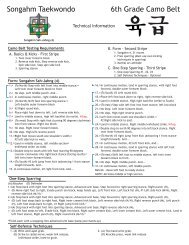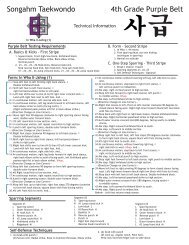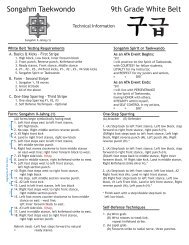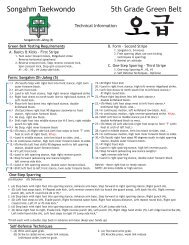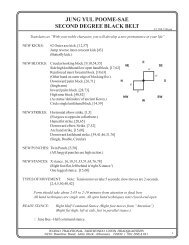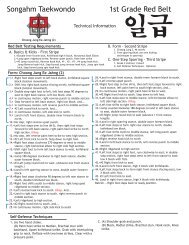In Wha 2 - West of the Moon ATA
In Wha 2 - West of the Moon ATA
In Wha 2 - West of the Moon ATA
Create successful ePaper yourself
Turn your PDF publications into a flip-book with our unique Google optimized e-Paper software.
Color Belt Philosophy<br />
The philosophical interpretation <strong>of</strong> <strong>the</strong> Blue Belt is:<br />
"The tree reaches for <strong>the</strong> sky towards new heights." Having passed <strong>the</strong> midway point, <strong>the</strong> student focuses his/her energy<br />
upwards toward Black Belt.<br />
Form - <strong>In</strong>dividual action<br />
Power comes from many different sources. Distance, timing, speed, and body weight - shoulder and hips must set<br />
direction <strong>of</strong> strike. Remember, power is a combination <strong>of</strong> all basic skills. If you have a problem displaying power, check <strong>the</strong><br />
following basics. Make sure you are performing your techniques correctly. Second, check your balance. And last, check<br />
with your instructor for more detailed guidelines.<br />
Segments break down: 5 - 6 - 5 - 6 - 4 - 6 - 4 - 6<br />
<strong>In</strong> <strong>Wha</strong> Ee Jahng (2) has 42 movements and its Ki-haps are on <strong>the</strong> 13th movement (twin upset punch), <strong>the</strong> 23rd movement<br />
(left knifehand low block), and <strong>the</strong> 33rd movement (right knifehand low block).<br />
Board Breaking - Evidence <strong>of</strong> Power<br />
Blue belts will break 1 station and only 1 board regardless <strong>of</strong> age or gender. Board sizes will be <strong>the</strong> same as prescribed in<br />
<strong>the</strong> <strong>In</strong>structor Manual.<br />
Techinique Requirements<br />
1. Front Kick<br />
2. Side Kick<br />
3. Round Kick<br />
Free Sparring<br />
Free sparring for testing should be done to exhibit proper technique for <strong>the</strong> Blue Belt level in combination form.<br />
The first stage <strong>of</strong> a winning strategy is to understand distance. The second stage is to look for <strong>the</strong> opponent's weakness -<br />
bad habits, slow movements, repeating patterns, etc.<br />
From Sir Walter Scott<br />
One hour <strong>of</strong> life, crowded to <strong>the</strong> full with glorious action, and filled with noble risks, is worth years <strong>of</strong> those mean<br />
observances <strong>of</strong> paltry decorum in which men steal through existence, like sluggish waters through a marsh, without ei<strong>the</strong>r<br />
honor or observation.<br />
Copyright 1984, 1988, 1990, American Taekwondo Association (10/2/90 revised #12 parallel to closed)



